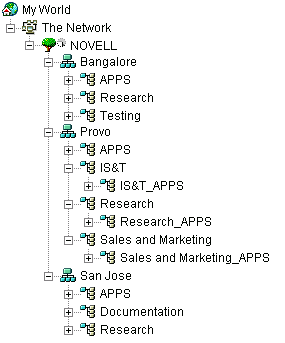51.2 Multiple Sites
If your eDirectory tree encompasses several sites, we recommend that you place your Application objects in the tree at the same site as the users who access them, and ensure that the eDirectory partition for that site is replicated to one or more servers at that site. Typically, this means that you have APPS containers at multiple sites, as shown below.
Figure 51-3 APPS Containers at Three Different Sites

In the above example, the eDirectory tree has been established geographically, with each Organization container comprising a different site. Ideally, this is the most efficient way to organize your tree. If you have not organized your tree by geographical location, you can still place Application objects in the same location as the users who access them, but you need to discover these locations.
Undoubtedly, you have an application that you need to distribute to users at all your sites. In this case, you should create multiple Application objects (at least one at each site) for the application.
When giving users access to the application, you would associate the users with the Application object located at their site. Ensuring that users are accessing applications at their own site speeds user access to the applications and reduces cross-site network traffic.
If you have users who travel from site to site, you can set up site lists for any applications you want them to have access to at all sites. An application site list ensures that the user is accessing the application from the site where he or she is located, regardless of which Application object the user has been associated with. For more information about site lists, see Section 48.0, Reference: Application Object Settings.